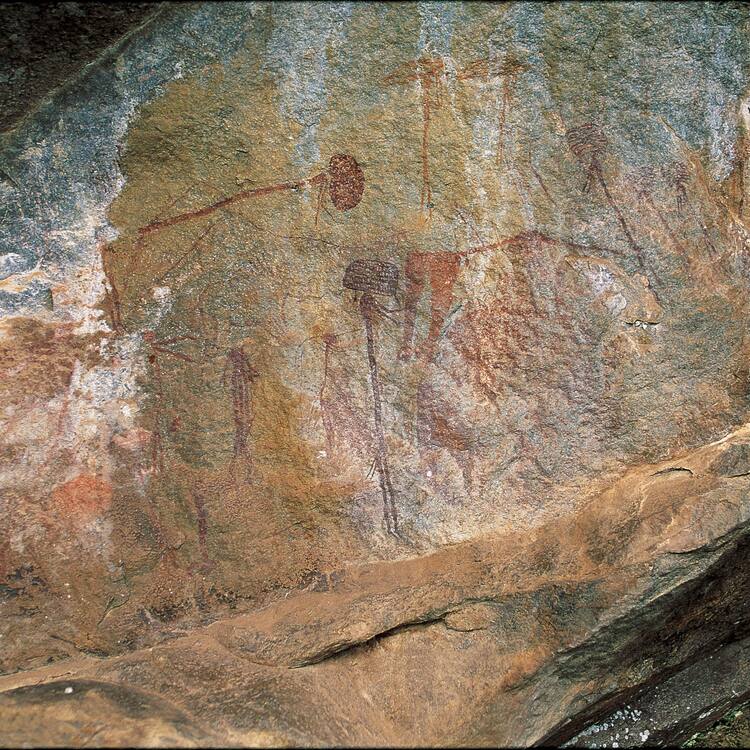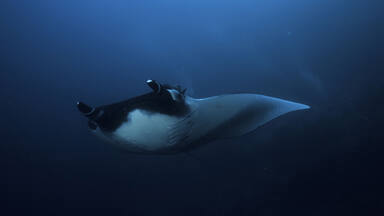Kondoa Rock-Art Sites
Kondoa Rock-Art Sites
On the eastern slopes of the Masai escarpment bordering the Great Rift Valley are natural rock shelters, overhanging slabs of sedimentary rocks fragmented by rift faults, whose vertical planes have been used for rock paintings for at least two millennia. The spectacular collection of images from over 150 shelters over 2,336 km2 , many with high artistic value, displays sequences that provide a unique testimony to the changing socio-economic base of the area from hunter-gatherer to agro-pastoralist, and the beliefs and ideas associated with the different societies. Some of the shelters are still considered to have ritual associations with the people who live nearby, reflecting their beliefs, rituals and cosmological traditions.
Description is available under license CC-BY-SA IGO 3.0
Sites d’art rupestre de Kondoa
Dans cette zone de 2 336 km2 située sur les versants orientaux de l’escarpement masaï bordant la grande vallée du rift, on trouve des abris sous roche naturels, surplombant des dalles de roches sédimentaires fragmentées par les failles du rift, dont les plans verticaux ont servi de support à des peintures rupestres pendant au moins deux millénaires. La collection spectaculaire d’images - souvent d’une grande valeur artistique - réparties dans plus de 150 abris présente des séquences qui constituent un témoignage unique de l’évolution socio-économique de la région, des chasseurs-cueilleurs aux sociétés agro-pastorales, et des croyances et idées qui leur sont associées. Les gens habitant aux environs des abris continuent de les associer à des pratiques rituelles.
Description is available under license CC-BY-SA IGO 3.0
مواقع كوندوا لفن النقوش والرسوم على الصخور
مواقع كوندوا لفن النقوش والرسوم على الصخور تحتوي هذه المنطقة الممتدة على مسافة 2336 كيلومترا مربعا عند السفوح الشرقية لمنحدر ماساي المحاذي لوادي الصدع الكبير على ملاجئ قابعة تحت الصخور ومطلة على بلاطات من الصخور الترسبية المحطّمة بفعل شقوق الصدع، علماً ان انحدارها العمودي شكل دعامة للوحات صخرية طوال ألفي سنة على الأقل. وتشكل مجموعة الرسوم المدهشة – التي غالباً ما تتسم بقيمة فنية كبيرة – والموزعة على أكثر من 150 ملجأ شاهداً على تطور المنطقة على الصعيد الاجتماعي والاقتصادي، من الإنسان الأول الذي كان يعيش من الصيد والقطف الى المجتمعات الزراعية الريفية، ناهيك عن معتقدات وأفكار مرتبطة بها، علماً ان القاطنين بجوار هذه الملاجئ لا ما زالوا يربطونها بممارسات شعائرية.
source: UNESCO/CPE
Description is available under license CC-BY-SA IGO 3.0
孔多阿岩画遗址
孔多阿岩画遗址位于东非大裂谷相连的马赛峭壁的东坡上,这是一处天然的岩荫,悬挂在被裂谷断层分开的沉积岩上。两千多年来,这些垂悬的岩壁被人们用作岩画的画板。这些壮观的岩画分布在150多个岩荫上,面积超过2336平方公里,很多具有极高的艺术价值。这些岩画按照一定的顺序排列,以一种独特方式展示了从狩猎采摘的原始社会到农牧时代该地区社会经济基础的变迁,以及人们的信仰和观念。其中一些岩荫至今仍被认为与附近居民的宗教仪式有关,反映了他们的信仰、仪式和传统的世界观。
source: UNESCO/CPE
Description is available under license CC-BY-SA IGO 3.0
Наскальные изображения в Кондоа
Кондоа – это территория на восточных склонах Масайского обрыва, примыкающего к Большой Рифтовой долине, с множеством естественных скальных укрытий, отвесные поверхности которых использовались для нанесения рисунков в течение, по крайней мере, двух тысячелетий. Замечательное собрание изображений, обнаруженных в более чем 150 укрытиях на территории свыше 2 236 кв. км, многие из которых обладают большой художественной ценностью, дают уникальную возможность проследить изменения социально-экономического уклада этого района от охотников–собирателей до сельского пастушеского общества, а также связанных с ними верований и убеждений. Некоторые из укрытий до сих пор сохраняют сакральное значение для местных сообществ, поскольку отражают их верования, ритуалы и космологические традиции.
source: UNESCO/CPE
Description is available under license CC-BY-SA IGO 3.0
Sitios de arte rupestre de Kondoa
Estos sitios se hallan en una zona de 2.336 km2 que se extiende por las laderas orientales de la escarpadura de la región de los masai, bordeando el Gran Valle del Rift. Poseen refugios naturales protegidos por losas sedimentarias fragmentadas por las fallas del rift, en cuyos planos verticales se encuentran pinturas rupestres ejecutadas a lo largo de dos milenios por lo menos. Diseminada en más de 150 refugios, la espectacular serie de figuras de estos sitios cuenta con muchas de gran valor artístico. Las escenas pintadas constituyen un testimonio excepcional de la evolución de la base socioeconómica de la región –transición de sociedades de cazadores-recolectores a sociedades agrícolas-pastorales– y de las creencias e ideas de los distintos grupos humanos que las representaron. Algunos de los refugios están vinculados a las creencias, los ritos y las visiones cosmológicas de las poblaciones vecinas, que los siguen utilizando para determinadas prácticas rituales.
source: UNESCO/CPE
Description is available under license CC-BY-SA IGO 3.0
コンドア・ロック‐アート遺跡群
コンドア・ロックアート遺跡群は、タンザニア中央部を走る大地溝帯に接したマサイ崖の東側斜面一帯、約2336k㎡を指す。周辺に暮らす民族は少なくとも過去2000以上にわたり、斜面の堆積岩の岩板の垂直面に岩絵を描いてきた。岩絵の多くは、この地域に点在する150以上の岩窟住居内に描かれ、その荘観なコレクションには、芸術的価値の高いものも多い。岩絵は、この地の社会的基盤が狩猟採集から農耕牧畜へと移り変わったこと、それに伴う人々の信仰や考え方が変化したことを伝える、貴重な資料である。同時に、今でも近隣に住む民族の信仰や儀式、伝統的な宇宙観などを反映していると思われる。source: NFUAJ
Kondoa rotskunstgebieden
Op de oostelijke hellingen van het Masai gebied bevinden zich natuurlijke rotsschuilplaatsen; overhangende platen van sedimentair gesteente, versnipperd door breukfouten. De verticale vlakken van deze schuilplaatsen zijn zeker twee millennia lang gebruikt voor rotstekeningen. Het is een spectaculaire verzameling van beelden uit meer dan 150 schuilplaatsen. De afbeeldingen – vele met een hoge artistieke waarde – geven een uniek beeld van de veranderende sociaaleconomische basis van het gebied – van jager-verzamelaars naar half-nomaden – en van de overtuigingen en ideeën horend bij die samenlevingen. Sommige schuilplaatsen zijn nog steeds gerelateerd aan de mensen in de omgeving. Voor hen weerspiegelen ze hun geloof, rituelen en kosmologische tradities.
Source: unesco.nl
Outstanding Universal Value
Brief synthesis
On the eastern slopes of the Masai escarpment bordering the Great Rift Valley are natural rock shelters, overhanging slabs of sedimentary rocks fragmented by rift faults, whose vertical planes have been used for rock paintings over at least two millennia.
The exact number of rock art sites in the Kondoa area is not yet known but it is estimated that there are between 150 and 450 decorated rock shelters, caves and overhanging cliff faces. The sites are located on the steep eastern slopes, an area of spectacular, fractured geological formations, which provided the necessary shelter for the display of paintings.
The extensive and dense collection of rock paintings represents and embodies the cultures of both hunter-gatherer and pastoralist communities who have lived in the area over several millennia.
The similarities with images from southern and central Africa, together with their distinctive streaky style and rare depiction of domesticated animals, make them distinctive examples of hunter-gatherer rock art at its northernmost limit.
In the spectacular collection of images from over 150 shelters, many have a high artistic value, and display sequences that provide a unique testimony to the changing socio-economic base of the area, from hunter-gatherer to agro-pastoralist societies, and the beliefs and ideas associated with them. Some of the shelters still have ritual associations with the peoples who live nearby, and are associated with the strong living traditions of the local population.
Criterion (iii): The rock art sites at Kondoa are an exceptional testimony to the lives of hunter-gatherers and agriculturalists who have lived in the area over several millennia, and reflect a unique variation of hunter-gatherer art from southern and central Africa and a unique form of agro-pastoralist paintings.
Criterion (vi): Some of the rock art sites are still used actively by local communities for a variety of ritual activities such as rainmaking, divining and healing. These strong intangible relationships between the paintings and living practices reinforce the links with those societies that created the paintings, and demonstrate a crucial cultural continuum.
Integrity
The boundaries enclose the extent of the main rock art sites. The boundaries do not follow any recognisable feature on the ground, although they are marked with embedded concrete posts.
Most of the rock art sites are stable and relatively well preserved. Although the rock shelters with paintings are located on the slopes of the escarpment or on the plateau and are generally surrounded by a wooded or bushy environment, there are some threats due to village land use practices. In particular, village farming, cattle grazing and harvesting of forestry resources are encroaching on the areas surrounding the rock art sites.
The forested or wooded environment surrounding the rock art sites creates a desirable protective measure for the paintings as this minimizes the effects of the sun, wind and dusts.
The woodland areas around the rock art sites give vital protection to the rock art, and are essential to control soil erosion and retain ground water. Deforestation, through the seeking of building materials and fuel, could seriously damage the images. A large number of sites were illegally excavated before inscription with a loss of contextual material.
One of the key qualities of the Kondoa rock art sites is that they still play an active role in the rituals of local communities. The sites are used for instance for weather-divination, healing and initiation. Whereas it is essential to sustain the links with local communities, there is also a need to ensure that use and conservation do not conflict. For instance in some of the rain-making rituals, animal fat and beer are thrown over the rock art paintings, perhaps a recent adaptation of older practices.
Authenticity
The authenticity of Kondoa rock art is beyond question. It has never been restored or enhanced in any way. What is of special importance about Kondoa is that the rock art exists, largely in its original natural environment, and in the context of a rich living heritage. The places where ancient hunter-gatherers painted rock art perhaps to influence the weather are still used today by local farmer communities in modern rain-making ceremonies. Modern versions of boys’ initiation ceremonies, which a few centuries ago may have led to the creation of certain white paintings, are still held every year in most of the villages in the area. Descendents of the Maa-speaking pastoralists, who once perhaps painted at a number of rock art sites in the area, still visit the area to graze their cattle during periods of drought.
A recent rock painting made by a Sandawe speaking man illustrated a remarkable persistence of artistic tradition, perhaps extending over several millennia.
Protection and management requirements
The Kondoa rock art site was initially managed by the National Monuments preservation ordinance No. 4 of 1937. This was repealed and replaced by the Antiquities Act No 10 of 1964, with its amendment Act No. 22 of 1979. Twelve Kondoa rock painting sites were given a special status and level of protection when they were scheduled as National Monuments in 1949. These sites were re-listed in 1981 when the Government of Tanzania published a new gazette, notice No. 39 published on 27 March 1981 with seven other sites added to the list. The property was declared a Conservation Area in 2004.
A Conservation Plan, started in 2001, was completed and updated in 2005. A Property Management Plan and Statement of Objectives were prepared in 2004. Both of these need to be regularly updated.
The existence of rock paintings in the area was first reported in 1908 and, although a variety of excavations were carried out during the 20th century, the rock art area at Kondoa has never been comprehensively surveyed. The records from these past surveys and work are scattered over a variety of institutions in different countries. At present there is no integrated documentation system for the sites. The management plan notes this as a matter of serious concern and, in order to support the management and monitoring, there is a need for the Department of Antiquities to create a central database of all documentation.
The management of the property will need to create a careful path between supporting the living heritage values of the sites and supporting the physical preservation of the sites. Working together with the Kondoa forest authority, the village governments and communities have now identified areas where trees can be grown for firewood.

